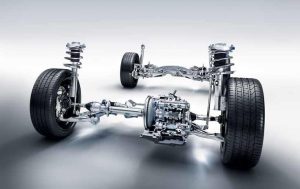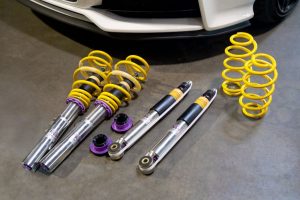When drivers think of suspension systems, they often focus on comfort — how smoothly the car absorbs bumps or vibrations. But suspension is much more than that. Its geometry —the precise angles and relationships between components like control arms, wheels, and steering — plays a fundamental role in how a car corners and stays stable on the road.
Suspension geometry determines how your tires maintain contact with the ground during acceleration, braking, and especially while cornering. Even a small adjustment in geometry can dramatically affect handling, safety, and tire wear.
What Is Suspension Geometry?

Suspension geometry refers to the spatial arrangement of the suspension components and how they influence the angles of the wheels relative to the road and vehicle body. The key parameters include:
-
Camber – the tilt of the wheel inward or outward from vertical.
-
Caster – the angle of the steering axis relative to vertical when viewed from the side.
-
Toe – the angle of wheels pointing inward or outward when viewed from above.
-
Roll center – the point around which the car body rolls in corners.
-
Anti-dive & anti-squat geometry – suspension setup that reduces nose dive during braking or squat during acceleration.
Together, these factors control how weight is transferred, how grip is maintained, and how predictable the car feels.
Why Suspension Geometry Matters in Cornering
Cornering is one of the most demanding situations for suspension. Forces act laterally, pushing the car outward while weight shifts to the outer wheels. If suspension geometry isn’t optimized, the car can feel unstable, lose traction, or wear tires unevenly.
Key Benefits of Correct Geometry in Cornering:
-
Better grip – wheels stay perpendicular to the road, maximizing contact patch.
-
Predictable handling – car responds consistently to steering input.
-
Reduced understeer/oversteer – balanced stability across all wheels.
-
Increased safety – stable cornering reduces rollover or sliding risk.
Main Geometry Parameters in Detail
1. Camber Angle
-
Negative camber (wheels tilted inward at the top): improves grip in corners.
-
Positive camber (wheels tilted outward): rare in modern cars, but sometimes used in off-road setups.
| Camber Setting | Effect on Cornering | Effect on Tire Wear |
|---|---|---|
| Neutral (0°) | Balanced, stable | Even tire wear |
| Negative (–1° to –3°) | High grip in corners | Slightly increased inner wear |
| Positive (+1°) | Poor handling, unstable | Excessive outer wear |
2. Caster Angle
Caster angle helps with straight-line stability and steering feel. A positive caster creates a self-centering effect.
-
High positive caster → stable at high speeds, better cornering grip.
-
Low or negative caster → light steering but unstable handling.
3. Toe Angle
Toe adjustments fine-tune stability and responsiveness.
-
Toe-in (wheels pointing inward) → increases straight-line stability.
-
Toe-out (wheels pointing outward) → improves quick cornering response.
| Toe Setting | Handling Effect | Tire Wear Impact |
|---|---|---|
| Neutral (0°) | Balanced response | Even tire wear |
| Toe-in | High stability, slower turn-in | Outer edge wear possible |
| Toe-out | Quick steering, agile cornering | Inner edge wear possible |
4. Roll Center Height
The roll center affects how much the car leans in corners.
-
Low roll center → smoother ride but more body roll.
-
High roll center → less roll but harsher ride.
How Suspension Geometry Affects Stability
While cornering performance is crucial, stability in daily driving — braking, lane changes, and uneven surfaces — is equally important.
Geometry’s Role in Stability:
-
Anti-dive geometry reduces front suspension compression under braking.
-
Anti-squat geometry prevents the rear from dipping during acceleration.
-
Correct roll center height minimizes excessive leaning that could destabilize the car.
-
Balanced geometry front vs. rear prevents understeer (front loses grip first) or oversteer (rear loses grip first).
Suspension Geometry in Different Vehicle Types
| Vehicle Type | Geometry Focus | Goal |
|---|---|---|
| Sports Cars | Aggressive camber, toe-out, high caster | Maximum grip and fast response |
| Family Sedans | Neutral camber, slight toe-in | Comfort, safety, tire longevity |
| SUVs/Off-roaders | Higher roll center, softer geometry | Stability on uneven terrain |
| Race Cars | Extreme negative camber, stiff geometry | Maximum cornering speed |
Challenges of Maintaining Proper Geometry
Even the best-engineered suspension loses effectiveness if alignment is incorrect. Potholes, curb hits, or worn bushings can change angles, reducing stability.
Common Problems:
-
Misaligned wheels → poor handling, increased tire wear.
-
Worn suspension bushings → unstable geometry under load.
-
Improper repairs → incorrect setup ruins cornering balance.
Practical Tips for Drivers
-
Check alignment regularly (every 10,000–15,000 km or after big pothole impacts).
-
Watch for uneven tire wear – a strong sign of geometry issues.
-
Invest in quality suspension parts – weak or cheap components ruin geometry accuracy.
-
Tune geometry based on use – track cars need aggressive settings, daily drivers do not.
If your vehicle needs replacement parts, you can Buy Suspension online to ensure precision and durability.
Conclusion

Suspension geometry is the hidden science behind how your car corners, grips, and stays stable. By controlling wheel angles and roll behavior, it ensures that tires deliver maximum performance while keeping the driver safe.
Whether you’re a performance enthusiast or a daily commuter, understanding suspension geometry helps you appreciate why proper maintenance and quality components matter. When tuned correctly, geometry provides the perfect mix of safety, comfort, and driving excitement — proving that even the smallest angles can make the biggest difference on the road.